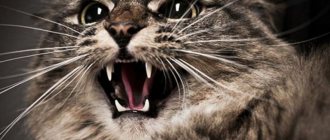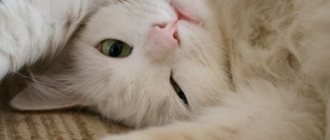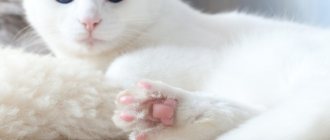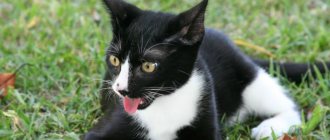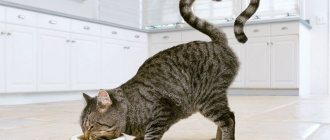7579Administration
Our mustachioed friends, cats, are very similar to ourselves, because they have some habits that are identical to humans. One of them is the habit of biting its claws. However, when it comes to pets, they do this for a reason or out of boredom. A cat bites its claws due to certain problems or circumstances. So why do mustaches do this?
There are 5 most common reasons for this:
- The pet has sore paws.
- The cat suffered significant stress for her.
- She lacks minerals.
- The mustachioed man is trying to get rid of his overly long claws.
- The animal has a fungal disease.
© shutterstock
So, now let's look at each reason in more detail.
Structure of a cat's claw
As noted above, the structure of a cat’s paw is quite unique, which allows the claws to retract and extend.
The noiselessness of the pet's movement mainly lies in the fact that it walks practically without its toes, without stepping entirely on its feet, while its claws are hidden. This allows the animal to sneak up on the victim as unnoticed as possible. Cats receive information from the world around them not only through their sense of smell and sight. They have very developed organs responsible for tactile sensations and air vibrations. The domestic cat receives information by touching objects or people with its paws, and also picks up air vibrations with the help of whiskers located not only on the face, but also between the pads of the toes.
In the vast majority of cases, the shape of cat claws is crescent-shaped. There are also exceptions to the rules. So, a cat of the Persian breed has a curved nail shape. This makes it possible to inflict dangerous injuries during fights with other animals, since the curved claws go directly under the skin.
Fingers
For many people, the phrase “cat toes” sounds unusual, but it is completely anatomically justified. Probably the reason for the misconception that cats have claws growing straight from their paws comes from the fact that the cat's toes are hidden under a layer of fur.
The fifth toe on the forelimbs most often remains invisible to the owner
On each cat's paw there are several toes, from which claws already grow. Unlike people, cats have a total of 18 fingers and the same number of claws:
- Cats have five toes on each of their front paws;
- The hind legs are equipped with only four toes.
The different number of fingers is associated with different functions that the hind and forelimbs are endowed with. The hind legs are used primarily as a support, while the front legs are an important defensive and hunting tool. Due to the divergent tasks, the structure of the claw on the front and hind paws is also different.
Polydactyly is common among both humans and animals.
Photophobia is normal
Kittens are born blind. Their eyes are closed for a reason, they continue to form and prepare to meet a serious, irritating factor - light. The pupils, which dilate and contract, are partly responsible for the normal perception of light and visual information. When a kitten just opens its eyes, its pupils do not have time to adjust to the brightness of the light.
The cause of photophobia in adult cats that cannot be ignored is pregnancy. Cats expecting offspring behave very differently, some become more sociable, others more irritable. However, all pregnant cats have one thing in common: the closer the due date, the stronger the desire to build a nest.
Cats of certain breeds do not arrange a nest on their own, but wait for these steps from the owner. Usually the pet is very worried, meows, calls the owner and tries to take it to the site of the proposed nest. In this case, your task is to arrange a soft bed and monitor your pet, since she will also count on you during childbirth.
A cat that sets up a nest independently chooses a dark place and sits in it for a long time. Your task is to read thoughts and free up the space you like for arranging a nest. Believe me, this is in your best interest, since for most expectant mothers the shelf with your clothes seems to be the ideal nest. To prevent the cat from hiding, she needs help setting up a nest:
- Make a box with three high sides and one low.
- Cover the box with soft materials; you can lay a moisture-absorbing diaper on the bottom.
We invite you to read: A guinea pig is a child’s first pet.
A lot has been said and written about the prevention of viral diseases, but thousands of owners continue to ignore it. Viral diseases affect all cats, regardless of their age, gender and habitation. If your cat lives in an apartment, the likelihood of it becoming infected with certain viruses is not (!
A virus transmitted through contact with sputum (saliva, nasal and eye discharge) is infectious rhinotracheitis. The source of the virus can be brought into the house on shoes or clothing. Unvaccinated animals are more likely to get the disease; some cats remain carriers for several years or their entire lives. According to available data, feline rhinotracheitis is not dangerous to humans, although it can be caused by a strain of herpes.
If the animal does not receive proper treatment, pneumonia develops quite quickly. Kittens die in most cases. By the way, it is known that recovered carrier animals experienced relapses of the disease after suffering stress.
Rabies is a virus that scares everyone, but is rarely taken seriously. Mass vaccination during the years of the USSR made it possible to greatly “suffocate” the rabies virus, but modern ignorance of vaccinations threatens to return everything to normal. Infection occurs through bites. The virus always leads to the death of the animal and cannot be treated.
Rabies is dangerous for humans, and without appropriate treatment, it is fatal. The main symptoms of infection are:
- Fear of light and water.
- Very aggressive or affectionately depressed behavior.
- Foamy discharge from the mouth (not always).
- Tremors and convulsions.
- Sudden death.
I would like to hope that you will never have to do this, but (!) if you find suspicious symptoms in your cat, leave the room, close it and immediately call the doctor! If the diagnosis is confirmed, your pet is doomed and euthanasia will be a more humane option.
Why does a cat sharpen its claws?
Why a cat sharpens or chews its claws interests many beginners. In addition to sharpening its weapons, the cat sharpens keratinized processes due to discomfort. Thus, dead particles of claws cause inconvenience to the cat in the process of retracting them into the pad. The pet begins to get nervous and tries to bite off or grind off the interfering layer.
We suggest you read: Is it possible to sterilize a cat after estrus?
This is what most often provokes the animal to tear up the sofa, curtains or other suitable surfaces. It is almost impossible to avoid this, so it is recommended to first purchase a special scratching post and accustom the animal to it. The cat will know the right place where it can easily sharpen and put its defense weapon in order.
If a cat chews its claws, or lets them into the owner’s body while lying on its knees, it should not be scolded under any circumstances. Thus, the animal leaves its specific secret on its beloved owner, indicating to other animals that the owner is busy.
Another reason that a cat begins to “sharpen” its claws on its owner is the so-called milk step. This phenomenon is caused by reflexes from childhood. At an early age, kittens intensively knead their mother's belly with their paws and thus stimulate the flow of milk. Not wanting to receive such affection from a mustachioed pet, veterinarians recommend regular trimming of cats' claws or purchasing special caps for the claws.
Fungal diseases
And finally, the last and very dangerous reason is a fungal infection. This disease is easy to detect because it often appears on the claws of the front paws. Taking a closer look at your pet's claws, you will be able to see their deformation, peeling, clouding and peeling. In advanced cases, the claw may even die. In addition, it should be remembered that a sick pet can become a source of infection for other animals or people. Therefore, you should definitely use the help of a specialist and follow all veterinary instructions.
In general, if you notice that your cat is biting its nails, you should not push this problem into the background. The sooner you deal with it, the easier it will be for you to avoid further troubles related to your pet’s health.
Stress or fear
Stress is the most harmful factor for an animal's health. Nothing weakens the immune system and the body as a whole more than constant worry and lack of opportunity to rest and sleep soundly. Fear and stress are closely related and often inseparable concepts. A cat's fear may not be obvious, since four-legged animals are good at masking their condition.
Common causes of guaranteed and severe stress include:
- Moving, sudden change of environment or travel.
- A trip to the veterinary clinic.
- The appearance of a child, a new partner or animal in the house.
- Unfamiliar or noisy guests.
- Lack of communication with the owner.
- Cat escapes from home.
There are so many causes of moderate or mild stress that it is pointless to list them. It is important to understand that a cat can be nervous about any reason. Very often, owners sincerely love their pet and give it the best, but the cat burns out from stress because it smells another animal at the front door or sees a competitor from the window.
The cat's claws are peeling
Sometimes owners notice that their cat's claws begin to peel. In such cases, you should not panic and assume the worst. The most common reason why a cat's nails peel is the normal physiological process of growth. Under normal natural conditions, cats' claws grow quickly, and the old stratum corneum dies off and is replaced by a new one. Healthy animals peel off the stratum corneum on a scratching post, thus regulating the peeling.
We suggest you read: Can a cat get calcivirus again?
Other reasons for claw delamination are improper cutting of the appendage. As a rule, detachment caused by improper haircut is immediately noticeable. The cause is an incorrect cut or blunt tools used for cutting.
Also, a cat’s claw detachment can be caused by a severe lack of essential vitamins and minerals. Quite often, cats with a lack of vitamins are diagnosed with problems not only with their claws, but with their skin and fur. A diagnosed deficiency of minerals and vitamins in an animal’s body requires a special approach. The pet is transferred to specialized food, enriched with all necessary nutrients.
In order to prevent your pet’s claws from splitting, it is recommended to properly trim the processes and also carefully monitor the quality of the diet. Each pet should have its own scratching post at home in order to freely approach it if necessary.
Nail trimming is also done regularly depending on the degree of growth. If it is difficult for the owner to treat and remove claws, it is recommended to contact a veterinarian. He will help and show you how to trim your nails correctly, as well as how to avoid possible injury.
Author and presenter of the column: Veterinarian Igor Viktorovich Sanaev
Do you want to know more about the article or something? Call 79774692712, we will advise you.
Lack of minerals
The desire to bite claws may be due to a lack of minerals in the body or their imbalance. Unable to find a more suitable source, the cat gnaws on mineralized parts of its own body. A similar condition is noted:
- with a poor, monotonous diet;
- during a period of intensive growth;
- during pregnancy and breastfeeding;
- after injuries during fracture healing;
- in case of poor calcium absorption and hormonal diseases.
Associated symptoms. An additional symptom of a lack of mineral nutrition is the instinctive need to lick, chew and swallow:
What should the owner do? To correct the situation, it is necessary to transfer the animal to a nutritious diet, using premium and super-premium food, and with natural feeding, provide high-quality vitamin and mineral premixes.
How to help your pet?
There are techniques that are guaranteed to help any cat deal with stress. If your assumption is wrong and the pet is not nervous, he will, in any case, accept these innovations with delight. The first tip concerns the animal's self-confidence. All cats love to look down on their territory.
The next point concerns safety. Even if your cat is very sociable and only sleeps in your bed, make sure she has some privacy. It’s quite simple to bring this to life - almost all tailed animals love to climb into boxes, baskets or wardrobes.
Sedatives that are produced specifically for cats are more quickly effective. The modern market offers several options:
- Sedatives – tablets and drops.
- Calming collars, sprays and fumigators.
